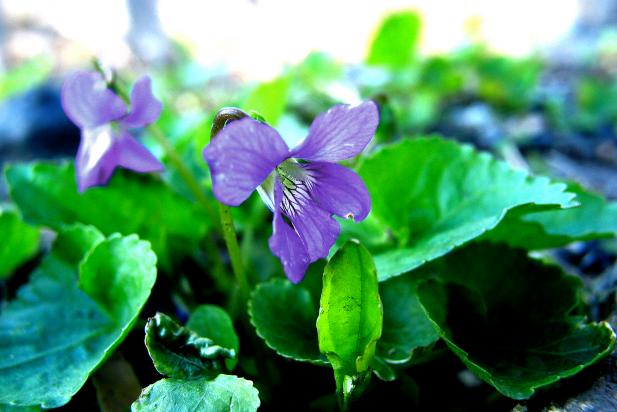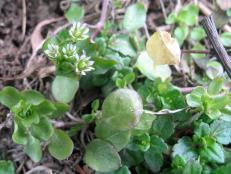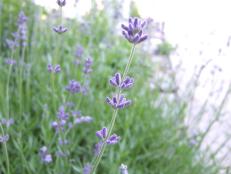Edible Common Blue Violet for Your Supper Plate

Foraging expert Steve Brill has shared his foraging wisdom at schools, museums, parks departments, environmental organizations, and with scout troops since 1982. He’s written three books and an app, stars in a DVD and maintains a website at Wild Man Steve Brill.
COMMON BLUE VIOLET (Viola sororia sororia, v. papilionacea)
Description
This common, widespread, native colonial perennial’s only leaves are basal. Odorless, heart-shaped, hairless, shallow-toothed, violets grow 3 to 5 inches long and as wide as they’re long. Tightly curled at first, each leaf grows on top of a single, slender, hairless leafstalk 3 to 8 inches high.
Barely taller than the leaves, each bilaterally symmetrical, scentless violet-colored flower also arises from the ground on its own slender, hairless flower stalk. Of the five rounded petals, the two side ones are bearded with bushy stamens near the flower’s throat; the three lower ones are deeply veined; and the lowest is slightly spurred. Hundreds of these colorful flowers, 0.75 to one inch across, fill meadows in early- to mid-spring, arising from the branched rhizomes (underground stems) about 0.5 inch thick.
These showy springtime flowers are sterile, but in the fall, the fertile flowers — inconspicuous oblong, beige capsules about 0.5 inch long, hide at ground level. They self-fertilize, mature and split lengthwise into three long, narrow troughs, to release a few dozen tiny, spherical seeds that look like ant eggs, translucent white at first, then dark brown when mature.
Seasons
The leaves are edible from early- through mid-spring, before they get tough and coarse in late spring, although sometimes new tender leaves come up where the older ones were mowed, and occasionally, you can find a few new, young leaves coming up in late fall. The edible flowers bloom in toward the end of early spring, into the start of mid-spring.
Habitat
Violets grow in gardens, lawns, meadows, fields, parks, damp woodland openings, trail edges, near riverbanks and along roadsides.
Range
Violets grow wild in eastern and much of central North America, although people can plant them in gardens anywhere.
Harvesting
In early and mid-spring, hold down handfuls of plants with one hand, and pull off as many leaves and violet flowers as possible, with as little of the tougher flower- and leaf stalks as possible. Other parts of the plant are not edible.
Food Preparation
Violets have a mild, subtle but quite enjoyable flavor — somewhat bland at first but with a surprise bite as part of the aftertaste. They’re excellent raw, in salads and sandwiches, and they’re great as cooked greens, steamed and served with olive oil, salt and pepper or in any vegetable dish that calls for cooked greens. They make an excellent replacement for spinach, for example, and cook in about 10 minutes.
Nutrition
The leaves provide vitamin A and C; the flowers, vitamin C.
Medicinal Uses
Not much used by herbalists nowadays, a poultice of the leaves has been applied externally to relieve headaches and for boils, and an infusion of the leaves and flowers has been used for dysentery, constipation, coughs and colds, although I’m very skeptical about any of these uses actually working.
On the other hand, violet leaves contain genistein (also present in red clover), and isoflavone (a plant estrogen and anti-oxidant) that some think may lower the risk of cancer. Laboratory research shows that genistein alters the action of the genes that prostate cancer cells use to spread throughout the body, and research is underway to determine whether taking genistein benefits prostate cancer patients.
Cautions
Eat only the young leaves in the spring or fall, and the violet flowers that bloom in the spring. Don’t eat the rhizomes, which may cause nausea and vomiting, or the inconspicuous ground level fall flowers, fruit or seeds.
Similar Plants and Confusing Factors
There are close to 80 similar edible violet-colored violet species in the U.S., and even the common blue violet is now considered a subspecies of a highly variable species that includes, among others, a subspecies with a white flower (V. sororia ‘Albiflora’), and a very common hybrid of that subspecies with the blue form that results in a blue-and-white flower.
If that’s not enough of a confusing factor for you, I don’t know what is. My preference is to enjoy these violets and let the botanists who are paid to do so work out the differences.
Violets with yellow flowers, such as the round-leaf yellow violet, which grows in swamps (V. rotundifolia), are edible as well. Another tasty species is the swamp blue violet (Viola cucullata), easy to distinguish because its flower rises high above the basal leaves.
Young garlic mustard’s (Alliaria petiolata) edible leaves resemble violets’, but they’re rounded, not pointed. Unlike violets, they grow in a basal rosette before a tall stem with white, four-petaled flowers appear; their leaf margins are wavy, they’re very deeply veined, and they smell like garlic when crushed.
Common mallow (Malva neglecta) leaves also look a little like violets’, but the leaves are pleated, as well as being rounded rather than pointed, and again, the flowers and fruits are completely different.
The Mythology of Violets
After Zeus took up with a beautiful wood nymph named Violet in the forest, he hid her from his jealous wife by turning her into a cow. Later she got hungry and tried eating tough grass blades. This hurt her mouth and made her cry. Zeus felt sorry for her and turned all her teardrops into violets.
Only 3,000 years later, I had a daughter, born in 2004, who we named Violet, but she’s learned so many plants by now that if anyone ever turns her into a cow, she’ll know what to eat!
Violet Kasha for Violet
After I read my then-6-year-old daughter Violet, A Horn for Louis (Armstrong—I’m a big jazz aficionado) at bedtime, where kasha was cooked, I decided to create a dish for her. Violet leaves add a creamy texture and wild touch to this traditional eastern European grain. Kasha is one of the first dishes I made after I took an interest in cooking in 1976, and this is my tastiest version to date.
4 cups sesame oil
2 red onions, chopped
6 cloves of garlic, chopped
1/4 cup sesame oil
2 cups violet leaves
1 tablespoon Vege-sal (available in health food stores) or seasoned salt, or to taste
2 teaspoons rosemary, ground
1/2 tablespoon tarragon, ground
1 teaspoon thyme, ground
1/4 teaspoon black pepper, ground
4 cups water
1. Sauté the onions and garlic in the sesame oil 20 minutes, or until browned.
2. Add the remaining ingredients, bring to a boil over medium heat, reduce the heat to low and simmer, covered, for 20 minutes, or until all the water is absorbed.
Makes 6 cups
Preparation time: 10
Cooking time: 40 minutes
Editor’s Note: The content of this article is provided for general informational purposes only. Be cautioned that some wild plants can be poisonous, and poisonous plants sometimes resemble edible plants which often grow side by side. It is the responsibility of the reader, or the reader’s parent or guardian, to correctly identify and use the edible plants described. HGTV does not guarantee the accuracy of the content provided in this article and is not liable for any injury resulting from use of any information provided.
This article is not intended as medical advice. Always consult a professional healthcare provider before trying any form of therapy or if you have any questions or concerns about a medical condition. The use of natural products can be toxic if misused, and even when suitably used, certain individuals could have adverse reactions.








































